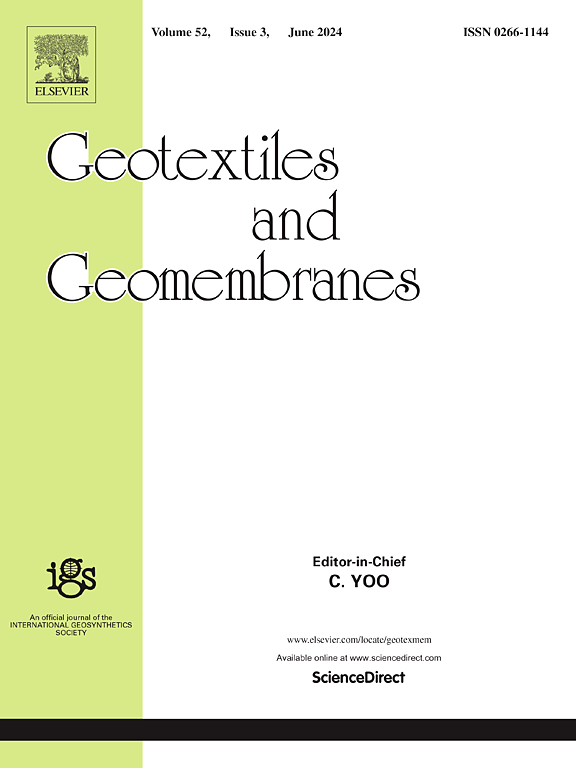A 9-year study of the degradation of a HDPE geomembrane liner used in different high pH mining applications
IF 4.7
1区 工程技术
Q1 ENGINEERING, GEOLOGICAL
引用次数: 0
Abstract
The degradation of a HDPE geomembrane in heap leaching environments is evaluated using immersion tests at five temperatures. The incubation solutions had a pH of 9.5, 11.5, and 13.5, relevant to gold and silver pregnant liquor solutions. After 9.3 years, the geomembrane's mechanical properties had reached nominal failure at 95, 85, and 75 °C in all three solutions. It is shown that the pH 13.5 solution had the greatest effect on the antioxidant depletion (Stage I) and polymer degradation (Stage III), but was the least aggressive to initiate the degradation (Stage II) compared to the pH 11.5 and 9.5 solutions. Overall, the time to nominal failure (time to 50% of the initial or specified property value) in pH 13.5 was slightly shorter than the pH 9.5 and 11.5 solutions. Based purely on immsersion tests, the time to nominal failure of this specific geeomembrane at 30oC is predicted to be 150 years in the pH 9.5 and 11.5 solutions, and 140 years in the pH 13.5 solution. Assuming a good liner design that limits the tensile strains in the GMB, nominal failure in a composite liner configuration is predicted to exceed 260 years at 30 °C and the expected value could exceed 1000 years at 10 °C.
对高密度聚乙烯(HDPE)土工膜衬垫在不同高 pH 值采矿应用中的降解情况进行为期 9 年的研究
通过在五种温度下进行浸泡试验,评估了高密度聚乙烯(HDPE)土工膜在堆浸环境中的降解情况。培养液的 pH 值分别为 9.5、11.5 和 13.5,与金和银的孕液溶液相关。9.3 年后,在所有三种溶液中,土工膜的机械性能在 95、85 和 75 °C 下均达到额定失效值。结果表明,与 pH 值为 11.5 和 9.5 的溶液相比,pH 值为 13.5 的溶液对抗氧化剂消耗(第一阶段)和聚合物降解(第三阶段)的影响最大,但对启动降解(第二阶段)的作用最小。总体而言,pH 值为 13.5 的溶液的标称失效时间(达到初始值或指定性能值 50%的时间)略短于 pH 值为 9.5 和 11.5 的溶液。纯粹根据浸入试验,在 30 摄氏度的条件下,pH 值为 9.5 和 11.5 的溶液中,这种特定的吉奥膜的标称失效时间预计为 150 年,pH 值为 13.5 的溶液中为 140 年。假定有一个良好的内衬设计来限制 GMB 中的拉伸应变,在 30 °C 时,复合内衬配置的名义失效时间预计将超过 260 年,在 10 °C 时,预期值可能超过 1000 年。
本文章由计算机程序翻译,如有差异,请以英文原文为准。
求助全文
约1分钟内获得全文
求助全文
来源期刊

Geotextiles and Geomembranes
地学-地球科学综合
CiteScore
9.50
自引率
21.20%
发文量
111
审稿时长
59 days
期刊介绍:
The range of products and their applications has expanded rapidly over the last decade with geotextiles and geomembranes being specified world wide. This rapid growth is paralleled by a virtual explosion of technology. Current reference books and even manufacturers' sponsored publications tend to date very quickly and the need for a vehicle to bring together and discuss the growing body of technology now available has become evident.
Geotextiles and Geomembranes fills this need and provides a forum for the dissemination of information amongst research workers, designers, users and manufacturers. By providing a growing fund of information the journal increases general awareness, prompts further research and assists in the establishment of international codes and regulations.
 求助内容:
求助内容: 应助结果提醒方式:
应助结果提醒方式:


